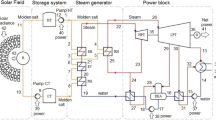Abstract
The solar power tower plant consists of thousands of heliostats, and heliostat field cost contributes nearly 40–50% of the total plant cost. This makes the cost of heliostat an important parameter while designing solar power tower plant, and it varies considerably with its size and wind loads. Furthermore, the size and aspect ratio of heliostat have a significant influence on the wind loads impacting its load-bearing components. While the importance of optimum size of reflector area has been studied by several researchers, its aspect ratio (width/height) has not been examined in detail. In this view, the main objective of this study is to identify the appropriate aspect ratio of a heliostat’s reflector area. An analysis of heliostat cost using its reflector area and the aspect ratio as variable parameters illustrates that heliostat cost per unit area can be minimized by distributing costs into various categories having different cost dependencies on area as well as aspect ratio. Using the component-wise cost break-up of 148 m2 Advanced Thermal Systems' heliostat as a reference, optimum area and aspect ratio of heliostat are determined parametrically. Further, a hypothetical power tower plant with 50 MW capacity and 6 h of thermal energy storage is simulated with heliostat fields comprising heliostats built with various aspect ratios and corresponding optimum reflector area. The results indicate that it is not only more economical to build heliostats with aspect ratio of around 2, but also such heliostat fields deliver higher optical efficiency on an annualized basis.














Similar content being viewed by others
References
Jones, S.A.; Lumia, R.; Davenport, R.; Thomas, R.C.; Gorman, D.; Kolb, G.J.; Donnelly, M.W.: Heliostat cost reduction study: Report by Sandia National Laboratory Albuquerque New Mexico USA (2007). https://doi.org/10.2172/912923
Rabbani, M.; Ratlamwala, T.A.H.; Dincer, I.: Development of a new heliostat field-based integrated solar energy system for cogeneration. Arab. J. Sci. Eng. 43, 1267–1277 (2018). https://doi.org/10.1007/s13369-017-2774-x
Weinrebe, G.; von Reeken, F.; Wöhrbach, M.: Towards holistic power tower system optimization. Energy Procedia 49, 1573–1581 (2014). https://doi.org/10.1016/j.egypro.2014.03.166
REN21 (2015) Renewables 2015-Global status report
Guédez, R.; Topel, M.; Spelling, J.; Laumert, B.: Enhancing the profitability of solar tower power plants through thermoeconomic analysis based on multi-objective optimization. Energy Procedia 69, 1277–1286 (2015). https://doi.org/10.1016/j.egypro.2015.03.155
Cádiz, P.; Frasquet, M.; Silva, M.: Shadowing and blocking effect optimization for a variable geometry heliostat field. Energy Procedia 69, 60–69 (2015). https://doi.org/10.1016/j.egypro.2015.03.008
Blackmon, J.B.: Heliostat size optimization for central receiver solar power plants. In: Concentrating solar power technology, pp. 536–577. SAIC (2012)
Ramamoorthy, R.: Sunshot vision study. SunShot, Department of Energy, USA (2012). https://www.energy.gov/sites/prod/files/SunShot%20Vision%20Study.pdf
Sastry, A.; Duvenhage, D.F.; Hoffmann, J.E.: A parametric study of heliostat size for reductions in levelized cost of electricity. South Afric. Solar Energy Conf. 2016, 1–8 (2016)
Blackmon, J.B.: Parametric determination of heliostat minimum cost per unit area. Solar Energy 97, 342–349 (2013)
Emes, M.J.; Arjomandi, M.; Nathan, G.J.: Effect of heliostat design wind speed on the levelised cost of electricity from concentrating solar thermal power tower plants. Sol. Energy 115, 441–451 (2015). https://doi.org/10.1016/j.solener.2015.02.047
Belhamadia, A.; Mansor, M.; Younis, M. A.: Assessment of wind and solar energy potentials in Malaysia. In: 2013 IEEE Conference on Clean Energy Technol, CEAT 2013, pp. 152–157 (2013). https://doi.org/10.1109/ceat.2013.6775617
Sakamoto, H., Arie, M.: Flow around a normal plate of finite width immersed in a turbulent boundary layer. J. Fluid. Eng. 105(1), 98–104 (1983)
Pfahl, A.; Buselmeier, M.; Zaschke, M.: Wind loads on heliostats and photovoltaic trackers of various aspect ratios. Sol. Energy 85, 2185–2201 (2011). https://doi.org/10.1016/j.solener.2011.06.006
Larmuth, J. N.; Landamn, W. A.; Gauché, P.: A top-down approach to heliostat cost reduction. In: AIP Conference Proceedings, vol. 1734 (2016). https://doi.org/10.1063/1.4949037
Blackmon, J.B.: Parametric determination of heliostat minimum cost per unit area. Sol. Energy 97, 342–349 (2013). https://doi.org/10.1016/j.solener.2013.08.032
Hussain, M.: Dependence of power law index on surface wind speed. Energy Convers. Manag. 43, 467–472 (2002). https://doi.org/10.1016/S0196-8904(01)00032-2
Peterka JA (1989) Mean and Peak Wind Loads on Heliostats. 111:
Wagner, M.J.; Wendelin, T.: SolarPILOT: a power tower solar field layout and characterization tool. Sol. Energy 171, 185–196 (2018). https://doi.org/10.1016/j.solener.2018.06.063
Stine, W.B.; Michael G.: Power From the Sun: Chapter 10; In: Science, pp. 857–861 (1968)
Mustafa, A.; Abdelhady, M.; Elweteedy, A.: Analytical study of an innovated solar power tower (PS10) in Aswan. Int J Energy Eng. 2, 273–278 (2012). https://doi.org/10.5923/j.ijee.20120206.01
Teufel, E.; Buck, R.; Pfahl, A.: Dimensioning of heliostat components under wind and gravity load: the map approach. In SolarPaces Conference, pp. 1–8 (2008)
Lopez, A.: India direct normal and global horizontal irradiation solar resources. NREL, USA. https://data.nrel.gov/submissions/43. Accessed 20 Nov 2018
Elayeb, M.E.; Haman, R.A.; Siala, F.M.F.: Calculation of the blocking factor in heliostat fields. Energy Procedia 57, 291–300 (2014). https://doi.org/10.1016/j.egypro.2014.10.034
Collado, F.J.; Guallar, J.: Campo: Generation of regular heliostat fields. Renew. Energy 46, 49–59 (2012). https://doi.org/10.1016/j.renene.2012.03.011
Kolb, G.J.; Jones, S.A.; Donnelly, M.W.: Power tower technology roadmap and cost reduction plan. Sandia Report SAND 2011–2419: Sandia National Laboratory USA (2011). https://prod-ng.sandia.gov/techlib-noauth/access-control.cgi/2011/112419.pdf
Author information
Authors and Affiliations
Corresponding author
Rights and permissions
About this article
Cite this article
Singhai, R., Sinhmar, H. & Banker, N.D. Effect of Aspect Ratio of Heliostat on Cost of Energy from Solar Power Tower Plants. Arab J Sci Eng 45, 877–890 (2020). https://doi.org/10.1007/s13369-019-04105-0
Received:
Accepted:
Published:
Issue Date:
DOI: https://doi.org/10.1007/s13369-019-04105-0




